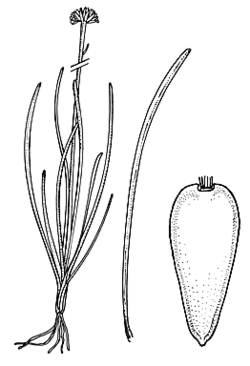Brachyscome obovata G.L.Davis APNI* Synonyms: Brachycome obovata G.L.Davis APNI*

Description: Perennial, rhizomatous herb to c, 45 cm high; remains of leaves not persisting at base of plant. Scapes 1–3 per tuft.
Leaves mainly in a basal cluster, linear or linear–oblanceolate, entire, glabrous, 4–25 cm long, 1–3 mm wide, apex acute, upper leaves much smaller; sessile, some leaves tapering at base and petiole-like.
Heads solitary, 8–20 mm diam.; peduncle broad, 15–25 cm long; involucral bracts 16–29, more or less in a songle row, obovate, green with scarious or purple margins, glabrous or with a few stalked glandular hairs. Ray florets 25–30, white or tinged mauve or purple, 10–13 mm long, 2- or 3-lobed. Disc florets c.50–70, 5-lobed. Stamens 5.
Achenes flattened, obovate, 2–3 mm long, brown, smooth, glabrous, brown; pappus of c. 15 stout, equal scale-like bristles c. 0.3 mm long.
Flowering: Late October to April.
Distribution and occurrence: Confined to the high country of eastern Victoria, the ACT and south-eastern NSW. Subalpine heathland, sphagnum bogs, Carex fen and the margins of steams.
NSW subdivisions: ST
Other Australian states: Vic.
Text by J. Everett; updated Louisa Murray (April 2017)
Taxon concept: Flora of NSW 3 (1992); updated from P.S. Short (2014) A taxonomic review of Brachyscome Cass. s.lat (Asteraceae: Asterae), including descriptions of a new genus, Roebuckia, new species and infraspecific taxa. Journal of the Adelaide Botanic Gardens 28: 1-219
APNI* Provides a link to the Australian Plant Name Index (hosted by the Australian National Botanic Gardens) for comprehensive bibliographic data
***The AVH map option provides a detailed interactive Australia wide distribution map drawn from collections held by all major Australian herbaria participating in the Australian Virtual Herbarium project.
|


